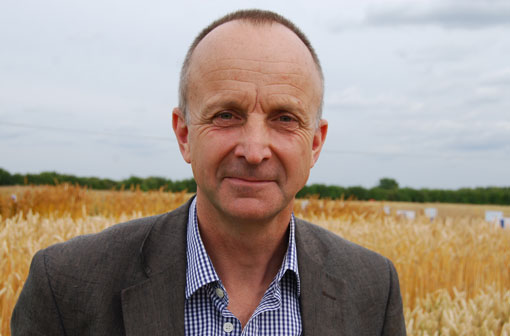Boosting wheat yields amid a shifting climate

During the 1970s and 1980s, wheat yields on farm were increasing by about 3% a year, a remarkable achievement brought about by a combination of improved genetics and better management practices.
However, since that time yield gain has slowed; it is now running at 0.5% a year, while on-farm yields have plateaued and are even declining in parts of the EU.
The situation must be reversed to ensure wheat growers can meet the twin challenge of coping with climate change and feeding a burgeoning global population, says Richard Summers, leader on Cereals Breeding at RAGT Seeds. Mr Summers was speaking at a recent Crops and Climate Change seminar, organised by the Cambridge Partnership for Plant Sciences and held at the NIAB Innovation Farm centre.
“I believe the UK will remain an area of high yield potential, though it will be touched by global warming. We can produce wheats for the UK that can cope with the sort of temperature rise we are likely to experience over the next 5-10 years by using genes for daylength response, temperature tolerance and vernalisation requirement found in current French and Mediterranean varieties.
“However, these genes will need to be recombined with others that are important for adaptation to UK latitudes and high yield potential.”
While that would be sufficient to maintain the current upward varietal yield trend, it would not meet the 1-1.5% annual increase needed if the world was not to go hungry by 2050.
To make matters worse, he suspected temperature was already affecting UK crop output. “Yields seem to have plateaued on farm in the UK for the past five or six years. I would love to think it’s to do with soil structure, rotation or the effects of economics.
“But I am increasingly worried that there is an overlying effect of climate change. Like NIAB-TAG’s Jim Orson, I suspect higher night temperatures are promoting respiration at the expense of photosynthetic efficiency.”
That was a big concern, he said. “It is likely that we will have to select varieties that can be harvested earlier. That must have a conflict with out-and-out yield and crop biomass, which means we have to find not only genes that deal with temperature, but also photosynthetic efficiency.”
In Eastern England, increasing frequency of drought was also likely to have a similar season-shortening effect.
However, globally, there was a “fantastic resource” of wheat genes available to help develop varieties that could cope with climate change, said Dr Summers. The development of a faster, cheaper and more efficient selection platform using genetic marker technology would help breeders select such varieties, he added.
“Empirical selection (selection from breeding populations and trials) will continue to serve us fantastically well. However, scientists and breeders need to ensure that fundamental science is successfully combined with variety breeding, rather than describing breeding advances retrospectively.
“Clear and far-sighted government policy is required to help such interactions and to ensure a vibrant plant breeding industry.”
While there was a fantastic toolkit available to understand plant genetics, applying these advances in a practical way was restricted by a lack of knowledge of phenotyping – how genes interacted with their environment to produce the typical plant seen in the field, said Eric Ober of Broom’s Barn.
“The genome is fairly easy to measure – phenotypic information is substantially more complicated. It matters where, when and how plants are grown – you need to know how plants are going to behave in the field.”
New UK facility
However, breeders and scientists could soon have access to much better information if plans for a UK field phenotyping facility for wheat come to fruition.
Several organisations, including Rothamsted, John Innes Centre, NIAB-TAG, ADAS and universities are currently trying to put together funding to create a site, which would be similar to several already introduced in other parts of the world.
These involved areas of thousands of plots where physical plant traits with a high genetic correlation to key targets such as yield, grain quality, resource use efficiency and stress resistance can be measured quickly and cheaply using remote sensing techniques.
Such traits include leaf area, chlorophyll content, plant height/width, growth rate, root mass/growth, leaf rolling and ear/panicle size/number, as well as drought, heat and frost tolerance.
“This is effectively doing what has been done in greenhouses by eye for years, only a lot more efficiently,” says Dr Ober.
“Once all this is in place, it will be very useful in helping to understand and accelerate breeding techniques to help meet the challenges of climate change.”
Cambridge Partnership for Plant Sciences
CPPS is a partnership of university departments, research institutes and industry which aims to strengthen and integrate pure and applied research in plant sciences in and around Cambridge. It provides a forum for the exchange of ideas and promotes research opportunities.

